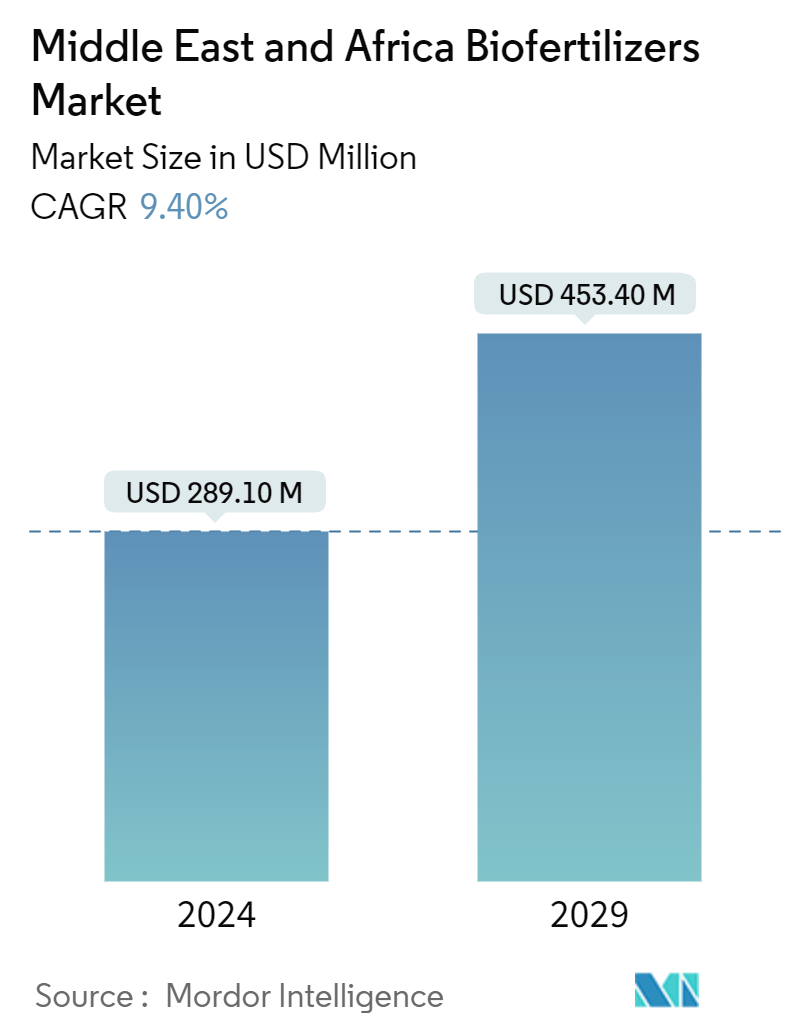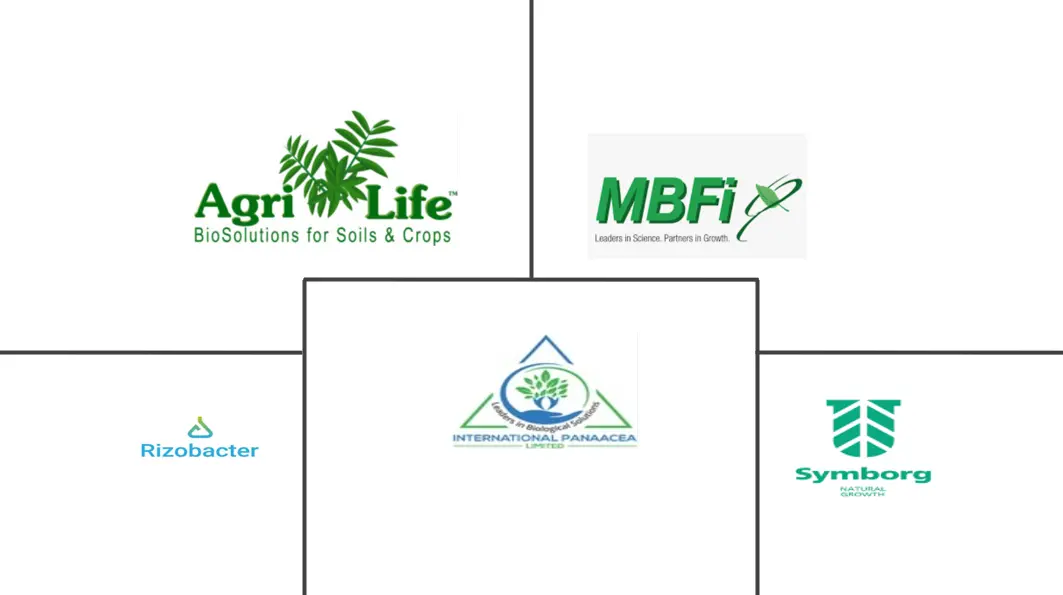Market Size of Middle East & Africa Biofertilizers Industry

| Study Period | 2019 - 2029 |
| Base Year For Estimation | 2023 |
| Market Size (2024) | USD 289.10 Million |
| Market Size (2029) | USD 453.40 Million |
| CAGR (2024 - 2029) | 9.40 % |
| Market Concentration | High |
Major Players
*Disclaimer: Major Players sorted in no particular order |
MEA Biofertilizer Market Analysis
The Middle East & Africa Biofertilizers Market size is estimated at USD 289.10 million in 2024, and is expected to reach USD 453.40 million by 2029, growing at a CAGR of 9.40% during the forecast period (2024-2029).
- The favorable government policies supporting the institutionalization of biofertilizers along with stipulated guidelines for its registration and distribution increased food demand for sustainable agriculture is driving the growth of the market. Lack of adoption of biofertilizers due to lack of awareness and dependency on imports of crops is restraining the middle east and Africa biofertilizers market.
- Carrier-based biofertilizers are occupying a major share in 2019 among other technologies. The higher prices of liquid biofertilizers as compared to carrier-based biofertilizers have led to the increased popularity of the latter among the regional farmers. Thus, the latter is driving the market revenue for the biofertilizers market.
MEA Biofertilizer Industry Segmentation
For the purpose of this report, biofertilizers have been considered within the scope of the research on plant nutrition. The market under study includes biofertilizers applied by owners or operators and commercial applicators to farms and facilities that are involved in the production of agricultural commodities.
| Microorganism Type | |
| Rhizobium | |
| Aztobacter | |
| Azospirillum | |
| Phosphate Solubilizing Bacteria | |
| Mycorrhiza | |
| Other Microorganisms |
| Crop type | |
| Row Crops | |
| Horticultural Crops | |
| Row Crops |
| Geography | ||||||||
| ||||||||
|
Middle East & Africa Biofertilizers Market Size Summary
The Middle East and Africa biofertilizers market is experiencing growth driven by supportive government policies and increasing demand for sustainable agriculture. The market is characterized by a significant share of carrier-based biofertilizers, which are preferred by regional farmers due to their cost-effectiveness compared to liquid biofertilizers. Despite these positive trends, the market faces challenges such as limited awareness and reliance on imported crops, which hinder broader adoption. The region's vast arable land, particularly in sub-Saharan Africa, presents opportunities for biofertilizers to address food insecurity and low soil fertility. The demand for alternative, cost-effective fertilizers is rising as smallholder farmers seek sustainable solutions to enhance productivity without degrading soil health.
In Africa, the shift towards biofertilizers is further supported by the economic constraints that limit the use of expensive inorganic fertilizers. The region's agricultural landscape, dominated by small and marginal farmers, is conducive to the adoption of biofertilizers as a means to improve crop yields and soil management. Prominent players in the market, such as Rizobacter Argentina and Agrilife, are developing tailored products to meet the specific needs of African farmers. The presence of both domestic and international companies contributes to the fragmented nature of the market, fostering competition and innovation. As the demand for sustainable and cost-effective agricultural solutions continues to grow, biofertilizers are poised to play a crucial role in the region's agricultural development.
Middle East & Africa Biofertilizers Market Size - Table of Contents
-
1. MARKET DYNAMICS
-
1.1 Market Overview
-
1.2 Market Drivers
-
1.3 Market Restraints
-
1.4 Porter's Five Forces Analysis
-
1.4.1 Threat of New Entrants
-
1.4.2 Bargaining Power of Buyers/Consumers
-
1.4.3 Bargaining Power of Suppliers
-
1.4.4 Threat of Substitute Products
-
1.4.5 Intensity of Competitive Rivalry
-
-
-
2. MARKET SEGMENTATION
-
2.1 Microorganism Type
-
2.1.1 Rhizobium
-
2.1.2 Aztobacter
-
2.1.3 Azospirillum
-
2.1.4 Phosphate Solubilizing Bacteria
-
2.1.5 Mycorrhiza
-
2.1.6 Other Microorganisms
-
-
2.2 Crop type
-
2.2.1 Row Crops
-
2.2.2 Horticultural Crops
-
2.2.3 Row Crops
-
-
2.3 Geography
-
2.3.1 Africa
-
2.3.1.1 South Africa
-
2.3.1.2 Kenya
-
2.3.1.3 Uganda
-
2.3.1.4 Tanzania
-
2.3.1.5 Nigeria
-
2.3.1.6 Rest of Africa
-
-
2.3.2 Middle East
-
2.3.2.1 United Arab Emirates
-
2.3.2.2 Saudi Arabia
-
2.3.2.3 Turkey
-
2.3.2.4 Egypt
-
2.3.2.5 Qatar
-
2.3.2.6 Rest of Middle East
-
-
-
Middle East & Africa Biofertilizers Market Size FAQs
How big is the Middle East & Africa Biofertilizers Market?
The Middle East & Africa Biofertilizers Market size is expected to reach USD 289.10 million in 2024 and grow at a CAGR of 9.40% to reach USD 453.40 million by 2029.
What is the current Middle East & Africa Biofertilizers Market size?
In 2024, the Middle East & Africa Biofertilizers Market size is expected to reach USD 289.10 million.

